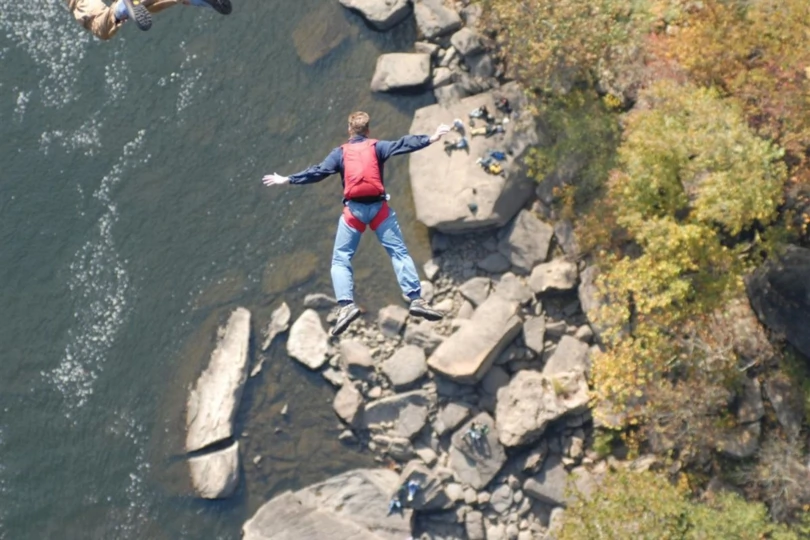Tandem BASE jumping is open for business in Moab, Utah. For just under $1,000, you can strap onto an instructor and leap off of a cliff in the desert.
Moab’s stunning red rock formations and canyons attract extreme sports athletes from all over the world to rock climb, off-road, mountain bike, slackline, and BASE jump legally year-round.
And you can take the leap with slackliner, climber and experienced BASE Jump Moab owner Andy Lewis — who rose to internet fame with death-defying YouTube stunts.
The appeal, Lewis said, is equal parts adrenaline rush and nature immersion: “It’s the ultimate leave-no-trace form of backcountry sport.”
BASE Jumping in Moab: A ‘Taste of Freedom’
Modern BASE jumping emerged in the 1970s. BASE jumpers launch themselves from fixed objects — building, antenna, span, or earth — and freefall for seconds before deploying their sole parachute. Unlike skydiving, there’s a lot less room for error.

And it’s a fairly dangerous sport. In 2016 alone, 37 BASE jumpers died according to the BASE Fatality List wiki. Most were killed during an uncharacteristically deadly summer season of wingsuit BASE jumping and tracking big cliffs in Europe. In a single week that summer, four Americans died while wingsuiting off of mountains in Italy, Norway, Canada, and France.
In an emotional Facebook post (since removed), Lewis claimed that wingsuit BASE jumping was to blame. The following year, the number of fatalities decreased dramatically, with only 18 deaths reported. But by 2018, it was back up to 32. While the causes vary, most were wingsuiters.
So, is BASE jumping safe enough for paying customers? Lewis says yes. He has over 10 years of experience and 2,000 BASE jumps under his belt. And he believes that education, risk management, and mentorship are key to making the sport safer and more accessible.
However, at the same time, the risk is undeniably part of the appeal. His dream is to “give people the ability to taste the freedom they’ve never had.”
Commercial BASE Jumping in Moab
Customers at BASE Jump Moab must submit an application and go through an interview process to assess their level of physical fitness and their response to fear. Lewis explained that, contrary to popular belief, there’s a lot of preparation that goes into a safe BASE jump. “It’s not an instant gratification thing,” he said.
Once conditions are right, customers hike to one of the three cliffs that have been permitted for tandem BASE students. They have names like Tombstone, The Sweet Spot, and Parriott Mesa. They’re also cliffs where experienced solo BASE jumpers have died or suffered injury.
“BASE jumping is a high-risk sport,” said Jim Webster, Grand County Search and Rescue commander. “And the consequences of failure can be fatal. However, when you look at the numbers, we respond more often to mountain biking, off-roading, and ATV incidents — and heat-related scenarios.”

The BASE community in Moab has long enjoyed a good relationship with the Grand County Sheriff’s Department and the Bureau of Land Management, unlike other parts of the U.S. where jumpers face arrest and the confiscation of their gear. Local BASE jumpers even organize an annual fundraiser to support Grand County Search and Rescue, according to Sheriff Steven White.
BASE Jumping Evolution
So, is BASE jumping finally cleaning up its bad-boy image? Lewis thinks so. “Any sport involving risk carries a social stigma,” he argued, “but that can be overcome.”
The proof may also be in the numbers. Professional BASE athlete Sean Chuma first began offering tandem BASE jumps in Twin Falls, Idaho, in 2009. In the past 10 years, he’s safely completed over 700 tandem BASE jumps with students from all around the world, including paraplegics, quadriplegics, and a journalist with cerebral palsy. His oldest student, Dorothy Custer, was 102 years old.
“It’s kind of a beautiful thing to share that experience,” says Chuma. “The public sees us as adrenaline junkies. But there are all kinds of people who BASE jump.”
That includes Moab resident Zenobia Sims, who recently completed two tandem BASE jumps.
“I came out here to climb and ended up jumping off a cliff,” said Sims.






